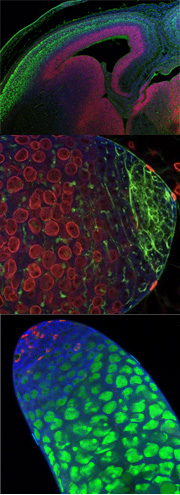
TSC
|
|||
|
To produce complex body plans, multicellular organisms must precisely coordinate cellular growth and differentiation. How these processes are regulated in time is poorly understood. We have recently found (Bateman & McNeill, 2004; Cell) that the insulin/TOR (target of rapamycin) signaling pathway, previously known only to regulate growth, also controls the timing of cell differentiation. Increased insulin signaling was found to trigger precocious photoreceptor differentiation in the eye imaginal disc, while reduced signaling causes delayed differentiation. Importantly, while cell fates were unchanged, tissue organization was lost due to faulty timing. These findings suggest an intriguing new mechanism for coordinating growth and differentiation in response to varying environmental decisions.
Figure 1. Differentiation in the Drosophila eye disc normally occurs in an anterior to posterior temporal gradient seen in this picture as the acquisition of different differentiation markers. Blue marks early neural fates, red and yellow indicate more mature photoreceptors. Anterior is to the left. We are currently using molecular and biochemical screens to determine the mechanisms by which the InR/Tor pathway regulates the timing of neuronal differentiation. Projects are available to use high-throughput RNAi approaches, as well as analysis of translational control mechanisms to address this problem.
Figure 2. Loss of TSC leads to precocious neuronal differentiation. Mosaic retinas with clones of homozygous mutant cells lacking TSC1, marked by loss of GFP. Anterior is to the left. Differentiation in the eye starts at the posterior of the eye, and moves forward in a wave of differentiation. Cells lacking TSC1 express many neuronal markers before their wildtype neighbors, including Bar ( top) and Prospero (bottom).
|
|||
Relevant Papers:
|
|||
|
Bateman and McNeill (2004) Cell |
|||
 |